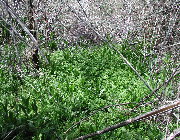 |
 | |
  | |
|
|
|
|
John Day Fossil Beds National Monument
Nonnative Species
|
|
|
|
|
|
 |
 |
| Poison hemlock and perennial pepperweed invading a riparian area. |
 |
NON-NATIVE SPECIES
With the discovery of gold in the upper John Day River area in the late 1860's, the large influx of Anglo-Americans has brought both major and subtle changes to the entire basin. The development of hay meadows in the river bottoms would soon remove many of the cottonwood galleries. Sheep and cattle ranches would soon be using the range resources, while timber mills would be set up to harvest the abundant forest products from the surrounding mountains. Along with the many comings and goings of the settlers would come weed seeds from other countries which today have quietly brought their own changes to the natural resources.
First and foremost among these invaders would be the grass known as cheatgrass. As the grass communities along the lower hills were impacted by heavy, and often yearlong, grazing, cheatgrass was able to gain a foothold and to outcompete the remaining grasses through fall germination, rapid growth in the spring while most native grasses were still dormant, and heavy seed production. Since the early to mid 1900's, cheatgrass has been joined by a host of other weeds such as Dalmation toadflax, whitetop, various knapweeds and thistles, yellow star-thistle, medusahead rye, poison hemlock, Russian olive, and many more. Each is equipped with extensive root systems or large seed crops or even both to allow their establishment. The river and stream corridors act as natural conduits for the seed along with the spread associated with their use by rodents and birds. Additionally, none of these plants brought along the pests and diseases from their native countries, and without exception, they all have mechanisms that make them highly unpalatable to native wildlife or livestock so they are not subject to the common factors that regulate species numbers in a native plant community.
Although the John Day Fossil Beds primarily consists of healthy, native plant communities, there are areas in each unit that have been impacted by historic grazing or have seen unwanted invasions coming up from the banks of the waterways. All of the species listed above can be found trying to invade the monument with varying degrees of success. Currently toadflax, the knapweeds, whitetop and medusahead rye would probably be considered the most established and toughest to keep under control.
The monument is taking a very active role in controlling the invasion of most of the species through the development of an Integrated Pest Management (IPM) plan, yearly efforts at locating and controlling new infestations, and ongoing efforts to maintain or re-establish healthy, native plant communities that are resistant to invaders. Impacts from other introduced species such as smallmouth bass, bullfrogs, and chukar partridges have not been studied, but may well be impacting other important resources of the monument.
|
|  |  |

|
 |
|
|
|
|
|
 |
|
Did You Know?
Brontotheres, large relatives of the horse and rhinoceros, once lived on the North American continent.
|
|
|
|
Last Updated: November 18, 2006 at 13:50 EST |






